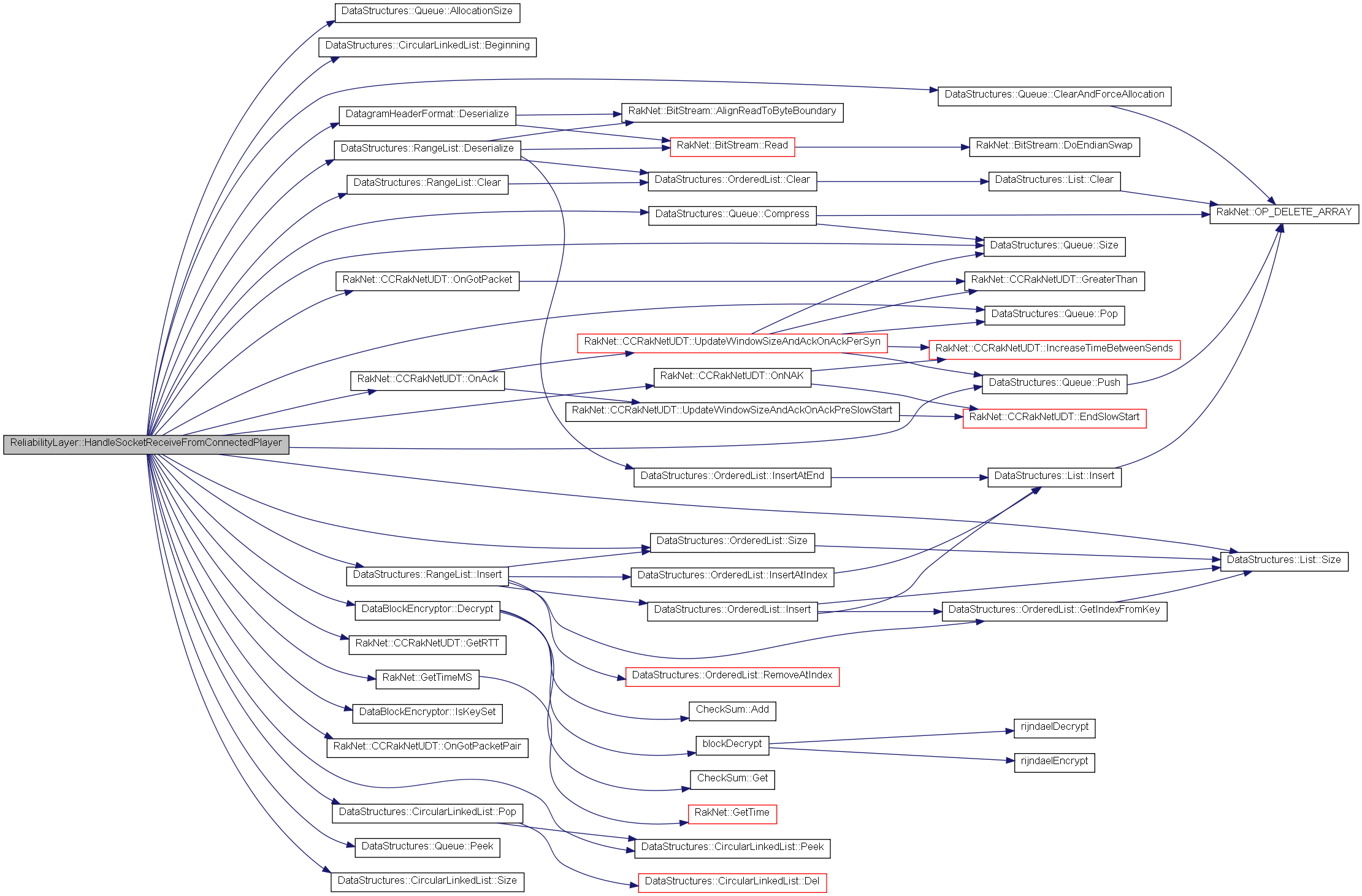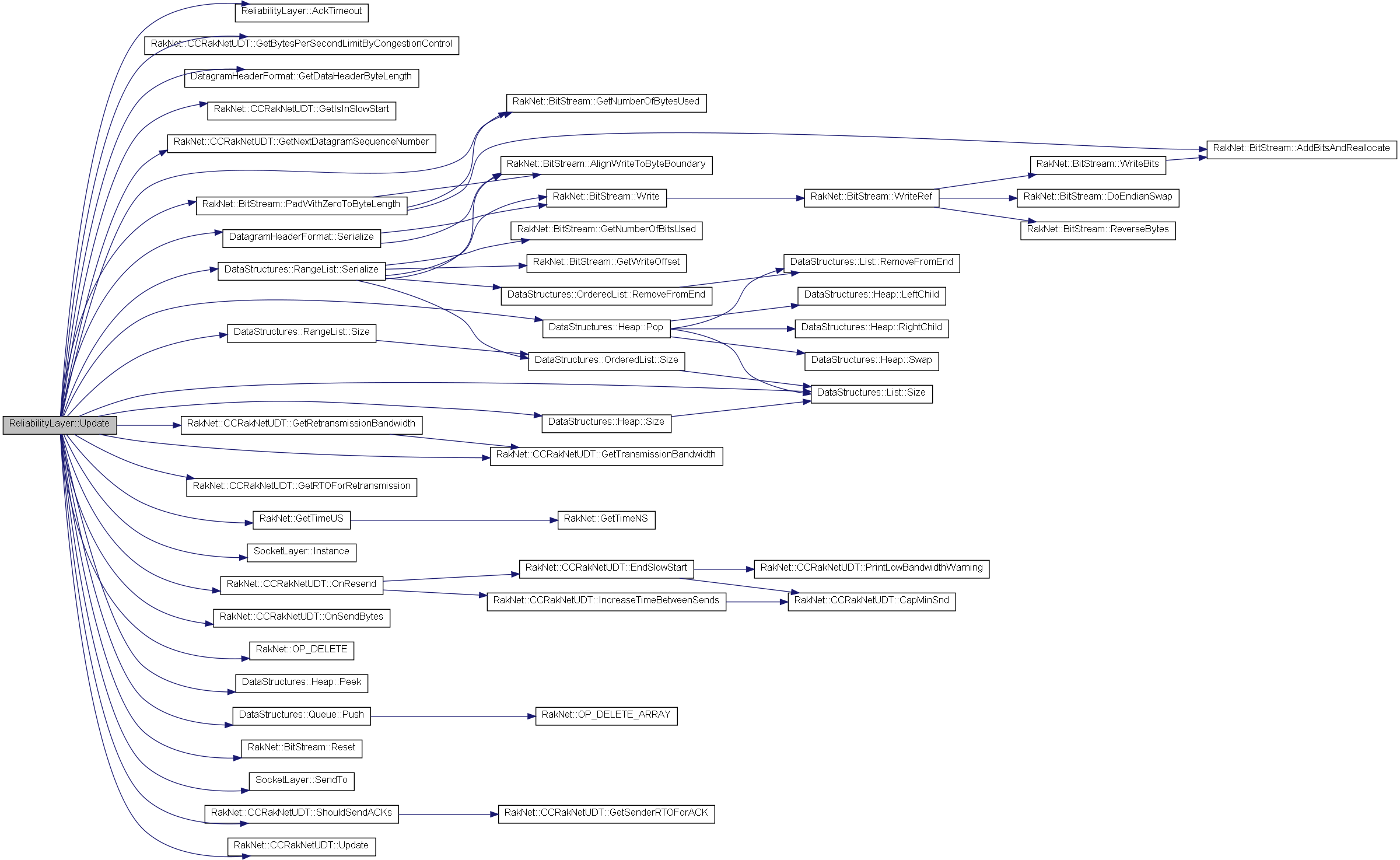Datagram reliable, ordered, unordered and sequenced sends. Flow control. Message splitting, reassembly, and coalescence. More...
#include <ReliabilityLayer.h>

Classes | |
| struct | DatagramHistoryNode |
| struct | MessageNumberNode |
Public Member Functions | |
| ReliabilityLayer () | |
| ~ReliabilityLayer () | |
| void | Reset (bool resetVariables, int MTUSize) |
| Resets the layer for reuse. | |
| void | SetEncryptionKey (const unsigned char *key) |
| void | SetTimeoutTime (RakNetTimeMS time) |
| RakNetTimeMS | GetTimeoutTime (void) |
| bool | HandleSocketReceiveFromConnectedPlayer (const char *buffer, unsigned int length, SystemAddress systemAddress, DataStructures::List< PluginInterface2 * > &messageHandlerList, int MTUSize, SOCKET s, RakNetRandom *rnr, unsigned short remotePortRakNetWasStartedOn_PS3, CCTimeType timeRead) |
| BitSize_t | Receive (unsigned char **data) |
| bool | Send (char *data, BitSize_t numberOfBitsToSend, PacketPriority priority, PacketReliability reliability, unsigned char orderingChannel, bool makeDataCopy, int MTUSize, CCTimeType currentTime, uint32_t receipt) |
| void | Update (SOCKET s, SystemAddress systemAddress, int MTUSize, CCTimeType time, unsigned bitsPerSecondLimit, DataStructures::List< PluginInterface2 * > &messageHandlerList, RakNetRandom *rnr, unsigned short remotePortRakNetWasStartedOn_PS3) |
| bool | IsCheater (void) const |
| bool | IsDeadConnection (void) const |
| void | KillConnection (void) |
| Causes IsDeadConnection to return true. | |
| RakNetStatistics *const | GetStatistics (RakNetStatistics *rns) |
| bool | IsOutgoingDataWaiting (void) |
| Are we waiting for any data to be sent out or be processed by the player? | |
| bool | AreAcksWaiting (void) |
| void | ApplyNetworkSimulator (double _maxSendBPS, RakNetTime _minExtraPing, RakNetTime _extraPingVariance) |
| bool | IsNetworkSimulatorActive (void) |
| void | SetSplitMessageProgressInterval (int interval) |
| void | SetUnreliableTimeout (RakNetTimeMS timeoutMS) |
| bool | AckTimeout (RakNetTimeMS curTime) |
| Has a lot of time passed since the last ack. | |
| CCTimeType | GetNextSendTime (void) const |
| CCTimeType | GetTimeBetweenPackets (void) const |
| CCTimeType | GetAckPing (void) const |
| RakNetTimeMS | GetTimeLastDatagramArrived (void) const |
Detailed Description
Datagram reliable, ordered, unordered and sequenced sends. Flow control. Message splitting, reassembly, and coalescence.
Definition at line 100 of file ReliabilityLayer.h.
Constructor & Destructor Documentation
| ReliabilityLayer::ReliabilityLayer | ( | ) |
| ReliabilityLayer::~ReliabilityLayer | ( | ) |
Definition at line 296 of file ReliabilityLayer.cpp.
Member Function Documentation
| bool ReliabilityLayer::AckTimeout | ( | RakNetTimeMS | curTime | ) |
Has a lot of time passed since the last ack.
Definition at line 2863 of file ReliabilityLayer.cpp.

| void ReliabilityLayer::ApplyNetworkSimulator | ( | double | _maxSendBPS, | |
| RakNetTime | _minExtraPing, | |||
| RakNetTime | _extraPingVariance | |||
| ) |
| bool ReliabilityLayer::AreAcksWaiting | ( | void | ) |
Definition at line 1915 of file ReliabilityLayer.cpp.


| CCTimeType ReliabilityLayer::GetAckPing | ( | void | ) | const |
Definition at line 2884 of file ReliabilityLayer.cpp.
| CCTimeType ReliabilityLayer::GetNextSendTime | ( | void | ) | const |
Definition at line 2874 of file ReliabilityLayer.cpp.
| RakNetStatistics *const ReliabilityLayer::GetStatistics | ( | RakNetStatistics * | rns | ) |
Get Statistics
- Returns:
- A pointer to a static struct, filled out with current statistical information.
Definition at line 2807 of file ReliabilityLayer.cpp.


| CCTimeType ReliabilityLayer::GetTimeBetweenPackets | ( | void | ) | const |
Definition at line 2879 of file ReliabilityLayer.cpp.
| RakNetTimeMS ReliabilityLayer::GetTimeLastDatagramArrived | ( | void | ) | const [inline] |
Definition at line 203 of file ReliabilityLayer.h.
| RakNetTimeMS ReliabilityLayer::GetTimeoutTime | ( | void | ) |
Returns the value passed to SetTimeoutTime. or the default if it was never called
- Parameters:
-
[out] the value passed to SetTimeoutTime
Definition at line 339 of file ReliabilityLayer.cpp.

| bool ReliabilityLayer::HandleSocketReceiveFromConnectedPlayer | ( | const char * | buffer, | |
| unsigned int | length, | |||
| SystemAddress | systemAddress, | |||
| DataStructures::List< PluginInterface2 * > & | messageHandlerList, | |||
| int | MTUSize, | |||
| SOCKET | s, | |||
| RakNetRandom * | rnr, | |||
| unsigned short | remotePortRakNetWasStartedOn_PS3, | |||
| CCTimeType | timeRead | |||
| ) |
Packets are read directly from the socket layer and skip the reliability layer because unconnected players do not use the reliability layer This function takes packet data after a player has been confirmed as connected.
- Parameters:
-
[in] buffer The socket data [in] length The length of the socket data [in] systemAddress The player that this data is from [in] messageHandlerList A list of registered plugins [in] MTUSize maximum datagram size
- Return values:
-
true Success false Modified packet
Definition at line 585 of file ReliabilityLayer.cpp.


| bool ReliabilityLayer::IsCheater | ( | void | ) | const |
If Read returns -1 and this returns true then a modified packetwas detected
- Returns:
- true when a modified packet is detected
Definition at line 2782 of file ReliabilityLayer.cpp.

| bool ReliabilityLayer::IsDeadConnection | ( | void | ) | const |
Were you ever unable to deliver a packet despite retries?
- Returns:
- true means the connection has been lost. Otherwise not.
Definition at line 2790 of file ReliabilityLayer.cpp.

| bool ReliabilityLayer::IsNetworkSimulatorActive | ( | void | ) |
Returns if you previously called ApplyNetworkSimulator
- Returns:
- If you previously called ApplyNetworkSimulator
| bool ReliabilityLayer::IsOutgoingDataWaiting | ( | void | ) |
Are we waiting for any data to be sent out or be processed by the player?
Definition at line 1898 of file ReliabilityLayer.cpp.


| void ReliabilityLayer::KillConnection | ( | void | ) |
Causes IsDeadConnection to return true.
Definition at line 2798 of file ReliabilityLayer.cpp.
| BitSize_t ReliabilityLayer::Receive | ( | unsigned char ** | data | ) |
This allocates bytes and writes a user-level message to those bytes.
- Parameters:
-
[out] data The message
- Returns:
- Returns number of BITS put into the buffer
Definition at line 1104 of file ReliabilityLayer.cpp.


| void ReliabilityLayer::Reset | ( | bool | resetVariables, | |
| int | MTUSize | |||
| ) |
Resets the layer for reuse.
Definition at line 303 of file ReliabilityLayer.cpp.


| bool ReliabilityLayer::Send | ( | char * | data, | |
| BitSize_t | numberOfBitsToSend, | |||
| PacketPriority | priority, | |||
| PacketReliability | reliability, | |||
| unsigned char | orderingChannel, | |||
| bool | makeDataCopy, | |||
| int | MTUSize, | |||
| CCTimeType | currentTime, | |||
| uint32_t | receipt | |||
| ) |
Puts data on the send queue
- Parameters:
-
[in] data The data to send [in] numberOfBitsToSend The length of data in bits [in] priority The priority level for the send [in] reliability The reliability type for the send [in] orderingChannel 0 to 31. Specifies what channel to use, for relational ordering and sequencing of packets. [in] makeDataCopy If true data will be copied. Otherwise, only a pointer will be stored. [in] MTUSize maximum datagram size [in] currentTime Current time, as per RakNet::GetTime() [in] receipt This number will be returned back with ID_SND_RECEIPT_ACKED or ID_SND_RECEIPT_LOSS and is only returned with the reliability types that contain RECEIPT in the name
- Returns:
- True or false for success or failure.
Definition at line 1140 of file ReliabilityLayer.cpp.


| void ReliabilityLayer::SetEncryptionKey | ( | const unsigned char * | key | ) |
Sets the encryption key. Doing so will activate secure connections
- Parameters:
-
[in] key Byte stream for the encryption key
Definition at line 320 of file ReliabilityLayer.cpp.


| void ReliabilityLayer::SetSplitMessageProgressInterval | ( | int | interval | ) |
| void ReliabilityLayer::SetTimeoutTime | ( | RakNetTimeMS | time | ) |
Set the time, in MS, to use before considering ourselves disconnected after not being able to deliver a reliable packet Default time is 10,000 or 10 seconds in release and 30,000 or 30 seconds in debug.
- Parameters:
-
[in] time Time, in MS
Definition at line 331 of file ReliabilityLayer.cpp.

| void ReliabilityLayer::SetUnreliableTimeout | ( | RakNetTimeMS | timeoutMS | ) |
| void ReliabilityLayer::Update | ( | SOCKET | s, | |
| SystemAddress | systemAddress, | |||
| int | MTUSize, | |||
| CCTimeType | time, | |||
| unsigned | bitsPerSecondLimit, | |||
| DataStructures::List< PluginInterface2 * > & | messageHandlerList, | |||
| RakNetRandom * | rnr, | |||
| unsigned short | remotePortRakNetWasStartedOn_PS3 | |||
| ) |
Call once per game cycle. Handles internal lists and actually does the send.
- Parameters:
-
[in] s the communication end point [in] systemAddress The Unique Player Identifier who shouldhave sent some packets [in] MTUSize maximum datagram size [in] time current system time [in] maxBitsPerSecond if non-zero, enforces that outgoing bandwidth does not exceed this amount [in] messageHandlerList A list of registered plugins
Definition at line 1288 of file ReliabilityLayer.cpp.


The documentation for this class was generated from the following files:




 1.7.1
1.7.1